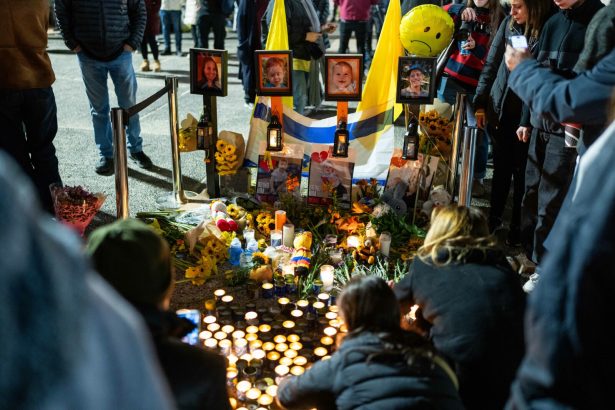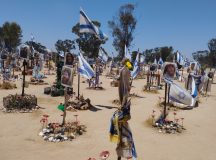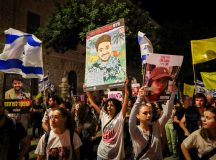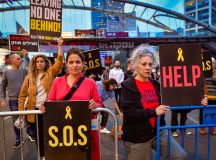The rubble at the site of the former Sderot police station – destroyed by an Israeli tank on the evening of 7 October – has been cleared and grass planted in its place. Now encircled by wrought iron, hundreds of stones that once formed the building are stacked tightly in a large semi-circle. Above them stand yahrzeit memorial candles, stories of Sderot residents who were murdered as Hamas terrorists invaded the city, as well as small trees and turquoise grey Helichrysums.
The centrepiece consists of 18 large columns (a number that represents chai, life). The Eternal Pillars Memorial reaches imperiously upwards with letters on the top of the columns spelling the words Am Yisrael Chai – the people of Israel live. Fluttering heavenward, those letters also symbolise a phrase by second century sage Rabbi Hananiah ben Teradion. The Talmud relates how he was tortured by the Romans, wrapped in a Torah scroll, and ultimately burned to death. When asked by his students what he saw, the sage responded: ‘the scroll is burning, but the letters rise towards heaven’.
Even though the scroll may burn, the memorial suggests, the letters and spirit remain for eternity.
The Sderot municipality engraved phrases of resilience onto those columns. One, from poet Erez Biton, exclaims how upon these ruins will be built a place of prayer to make room for a sanctuary. Another, from singer Hanan Ben-Ari, comes from his song, Moledet (homeland), formally released just a week after 7 October. ‘You will forever be my homeland, even on the brink of the tehom (abyss); ‘even in hell you are gan eden (paradise),’ Ben-Ari sings, in words now eternalised on the stone pillars.
In the Biblical creation story, just before the creation of light, God’s breath hovers over the tehom, described by textual commentator Avivah Zornberg as a place of emptiness – the murmuring deep. For me, it brings back memories of a piercingly beautiful piece by Israeli author David Grossman, whose son Uri was, tragically, killed in his tank in the final days of the 2006 Second Lebanon War. In an article marking Israel’s Memorial Day entitled HaHolchim Me’Al HaTehom (Over the Abyss), Grossman describes his ongoing pain in continuing life after loss.
He writes of how slowly, amid the endless negotiation with life, a way emerges for individuals to live with loss; how reality seems to spread over their wound like a tenuous, flexible fabric along which the mourners need to learn to journey forward. A fabric, Grossman explains, that is stretched above the abyss. While bereaved families often fulfill their obligations, walking along the fabric splendidly and heroically, the truth is that ‘there is no fabric above the tehom, the abyss. We pretend there is – but there isn’t.’
Grossman chooses to use the word tehom, abyss, because he does not believe there is any other word ‘to describe that. The absolute void, that dead suction,’ something he sees as impossible to describe and comprehend.
Because where death is – especially the death of a young person like Uri – logic is absent. It is unfathomable:
Sometimes I think – if we dare to truly understand what happened to our loved ones, if we touch even for an instant, with all our whole being, the core of that fact; if we allow ourselves to gaze into it in a way that allows no defence against it – the abyss will swallow us in a heartbeat. We too will be turned into not. This is perhaps the greatest task, our life-task, of those who have experienced a loss like this: to learn how to go forward on the fabric that guards us against the fall abyss-ward. And to know that there is no fabric that is guarding us. And even so, to go forward on it, and to fall time after time, and even so, to go forward. And even amid the fall, and within the abyss itself to go.
Another quotation in the centre of the stone-grey columns, alongside those from Hanan Ben-Ari and Erez Biton, completely floors me:
Atem Shel Yisrael? (Are you from Israel?)
Many Israelis know this quote. It is what 6-year-old Sderot resident Romi Suissa – in the car with her 3-year-old sister Lia and their dead mother Odaya outside the police station – asked a policeman who braved bullets to come and rescue them. When answered in the affirmative, she asked him to save them, adding ‘I have a baby here, I don’t want my sister to die’ (a six-year-old calling her three-year-old sister a baby!). Romi would tell her grandmother that Odaya had been full of blood. ‘She didn’t answer. I think she’s dead, savta.’
This too is now engraved in perpetuity.
In late January 2025, as the guns fell silent and the nation waited agonisingly, hostages began to be released. First were Romi Gonen, Emily Damari, and Doron Steinbrecher, followed later by the five tatzpitaniyot female lookouts Liri Albag, Karina Ariev, Agam Berger, Daniella Gilboa, and Naama Levy, who were taken hostage from the Nachal Oz base after 16 of their friends were brutally murdered.
A week later, Damari posted an Instagram photo of herself sitting defiantly on a couch outside her destroyed home in Kfar Azza – clad casually in ripped blue jeans, baseball hat, and sunglasses, and with two fingers missing on one hand. Alongside the mounds of white foam-stuffing from the destroyed black easy chair, lying silently on the ground like the almond blossom that was then encompassing Israel, Damari wrote ‘I’m back’. By returning to Kfar Azza, she explained, she had closed part of the circle. The rest was impossible until all the hostages came home.
Even though the scroll may burn, the letters and spirit remain for eternity.
As time advanced following that dark October day, so did my daughter Hadas’ ability to read. Last summer, she asked my wife Jess what the colorful posters around the neighbourhood meant. B-R-Ing. Them. Home, she mouthed slowly and carefully. Jess explained that people were taken by bad guys. ‘Did they take children too?,’ Hadas wondered aloud in her seven-year-old curious innocence. ‘Yes,’ Jess noted quietly, ‘but the children were returned.’
A few months later, as we waited for a bus near my son Idan’s kindergarten, Hadas and her friend judiciously studied a wall of hostage posters, with Yarden, Shiri, Ariel and Kfir Bibas – those children who despite Jess’ reassurances had notably not returned – directly on their eye level. ‘You know that kid is probably dead,’ Hadas’ friend pronounced, looking towards me earnestly for some sort of confirmation. And then four-year-old Idan chimed in: ‘they didn’t bring back the “abbas” (the daddies) because they know how to fight better,’ he told us, proud of himself for being able to participate in the conversation, his shoulder-length golden curls – a similar length to Ariel’s in the pictures – bobbing excitedly.
I looked at them silently, lost for words. I was ultimately saved by the arrival of the bus.
As January turned to February and late-winter storms swept the country, the daddies did begin to return. First were Keith Segal, Ofer Kalderon, and Yarden Bibas. Following them, after 491 days in captivity, came the thin, frail, and emaciated frames of Eli Sharabi, Ohad Ben Ami, and Or Levy. In one of countless examples of Hamas’ sadistic cruelty, gunmen had encouraged Sharabi to say he was looking forward to seeing his wife Lianne and daughters Noiya and Yahel again – knowing full well Sharabi was unaware that all three had been murdered in Kibbutz Be’eri.
After leaving their young son with her parents, Or Levy and his wife Eynav had reached Nova and then fled to the same migunit roadside shelter as Hersh Goldberg Polin. What struck me when I stood in that migunit months later was how ridiculously small it was; and how petrifying it must have been for 27 people to be crammed into an area no larger than 1.5 x 2.5 metres as gunmen lobbed in grenades. It was there that Eynav and 15 others were murdered, and Or taken hostage alongside Hersh, Eliya Cohen[1] and Alon Ohel (with seven people managing to survive by lying under dead bodies). Upon his release, Or had asked immediately of Hersh’s fate. Or’s parents meanwhile had told their grandson that Or was lost and people were searching for him. In their first video conversation, his now three-year-old son told him, ‘Abba, it took you a long time to come back.’
So much heartbreak.
So few words.
At the junction on Azza Street near our house, white-clad protesters sit quietly on blankets, plastic chairs, and asphalt – a far cry from those raucous protests of rage following news of the murder of Hersh, Carmel Gat and four other hostages in a Rafah tunnel in September 2024. This demonstration, called Mishmeret (Shift) 101 is mainly silent, without posters or placards. Hersh’s mother Rachel described it as a type of ‘silent scream’ – a phrase from 18th century Hasidic Rabbi Nachman of Bratslav regarding how to pray from within one’s pain.
Not suitably dressed for the occasion, I stand on the periphery. But I notice how their white clothes are now speckled with orange scarves, in support of the Bibas family. Seven oranges are arranged in a circle in the middle of the sit-in. As the demonstration concludes, everyone chants, ‘We are with you. You are not alone.’
The last time I visited Hostages Square in Tel Aviv was late September 2024. Near the entrance stood a long Passover Seder table with dozens of chairs and pictures of hostages. The chairs were mostly plastic and relatively non-descript, other than the names and photos of those in Gaza. Yet one, taken from the home of Ofer Kalderon, was completely singed. Towards the middle was a separate children’s table with pictures of Ariel and Kfir Bibas. By the photo of 9 month-old Kfir, visitors had laid a small grey teddy bear, alongside a book of large cats and a colorful volume of Sesame Street’s cookie monster ‘at the zoo’.
Back then, a large picture of Carmel Gat hung nearby. ‘Yoga for Carmel every Friday at 9.30 a.m. until she returns. Come turn worry into hope’, the sign encouraged visitors. A nearby artistic display entitled ‘One pita a day’ showed small pieces of curled crusted bread to symbolise the meager rations available to the hostages.
The square is a place in which personal and national griefs mix. A gargantuan clock with red digits, seconds hand ticking accusingly, stood next to the main stage. Posters were hung everywhere. One yellow spray-painted artistic display showed the five lookouts. ‘Look them in the eyes’, visitors are commanded. Another large poster with dozens of hostage faces hung nearby with the slogan ‘We only win when everyone returns home’. Underneath some of the hostages’ names, the words ‘they returned in coffins’ had been added in Hebrew. Another poster suggested a binary choice – iska (a deal) or hafkara (abandonment). One large blue billboard stated returning the hostages returns HaTikva, the hope. Yet it’s not just hope, but the very nature of the country, whose national anthem is The Hope. It’s an Israeli value that the country doesn’t leave anyone behind, that all Jews are responsible for one another.
Set back from the stage behind the reproachful clock was a large yellow wall saying ‘NOW!,’ in front of which were arranged rows of empty yellow chairs with different sets of eyes stuck on each chair. A small sticker on the wall near the underground car park said ‘no price is too high for the freedom of Ofer’. It referred to Ofer Tzarfati who, after helping his girlfriend escape from Nova, entered a different car and was badly injured. His dead body was recovered in Gaza by the IDF on 1 December 2023.
Back in September 2024, I walked slowly and deliberately through a mock tunnel that had been created for visitors. About 5 foot high (taller than the Rafah tunnels in which some hostages are kept) and full of graffiti, one would hear recorded sounds of footsteps above and distant explosions. Someone had drawn a picture of the two ginger haired Bibas children, with the adage that time is running out. Another expressed happy birthday wishes to Ariel, 8/5/2024.
Exiting into the bright sunlight, I saw a man accompanied by a television crew. With short salt-and-pepper hair, white stubble and a stoic complexion, Liri Albag’s father Eli was wearing a black T-shirt with her photo on it. ‘My daughter is being held in a tunnel like this, although much longer’ he relayed to a film crew. When pushed about the government’s handling of the hostage issue, Albag didn’t hold back. ‘The PM isn’t doing everything,’ he said. ‘People say that one can’t make a deal with Hamas. Then who should I make a deal with – the air?!’ His voice growing louder, he said ‘of course we need to fight our enemies, but in the end we will also need an agreement that will see us leave Gaza after everyone has been released.’ Emphasising he was no pacifist, Albag once again discussed the need to fight. ‘But to live,’ he added, ‘we need our hostages back.’
And then came Day 502. The day that four coffins – two pint-sized, with pictures atop of the octogenarian Oded Lifshitz, Shiri Bibas, and her two children – returned to Israel. The nation stood numb, collectively unable to properly breathe. Onlookers stood along the road, draped in Israeli flags, as the coffins were driven to be identified, breaking out in the national anthem Hatikva as they passed.
As the coffins made their way to Abu Kabir forensic institute, I returned to Hostages Square. Some of the posters were no longer there, although the clock continued ticking reproachfully. Dozens of Israeli flags fluttered gingerly in the Tel Aviv breeze, their Stars of David interlinked with yellow hostage threads. The yellow spray-painted artistic display of the five tazpitaniyot remained, but small heart-shaped stickers saying chazarti (‘I have returned’) were pinned above each face. The long Passover Seder table stood there too, but additional soft toys – a Winnie the Pooh, Tigger, Sonic the Hedgehog – and small batman shoes had been added to the children’s table.
We didn’t yet know Shiri Bibas wasn’t in the coffin, nor the brutal way in which the children had been murdered.
In one of the tents, volunteers sold books as part of the ‘Faith Project’, organised by the mother of hostage Yosef Ohana, who was taken from Nova. One of the books was of Rabbi Nachman of Bratslav’s teachings; the other, The Garden of Faith by Bratslaver Rabbi Shalom Arush, a book popular in certain spiritual circles trying to orient themselves towards seeing everything as being from God.
In the centre of the square, people sat on the floor and on chairs, watching the screen playing videos of hostages from an earlier and freer time. The collective mood was sombre. One young mother in an orange sweater holding a baby in a wool hat wept. Nearby, a group of men and women stood swaying, deep in the mincha afternoon prayer. I realised I had sought the comfort of crowds. Because when one faces the unfathomable, it is preferable to be with others. And sometimes our screams cannot remain silent.
After dark, a couple of hundred strangers stood around a piano in the square – placed there by the mother of Alon Ohel – as a young man wearing a kippah played melodies.
Acheinu Kol Bet Yisrael, we sang together, as for our brothers and sisters and for the whole House of Israel:
who are given over to trouble or captivity, whether they abide on the sea or on the dry land, may the All-Present have mercy upon them, and bring them forth from trouble to enlargement, from darkness to light, and from subjection to redemption, now speedily and at a near time. Amen
The pianist looked around self-consciously, open to suggestions. After something inaudible from the crowd, he began playing a tune from Psalms 121, ‘A Song of Ascents’: ‘I lift my eyes to the hills, from where does my help come?’ the crowd chanted quietly, ‘my help comes from the maker of the earth… Behold, He who keeps Israel will neither slumber nor sleep.’
Another pause. And then began a song from Hanan Ben Ari – not the one memorialised in the Sderot columns – called ‘Broken Hearts’, an emotion we all felt.
He that knows the pain I’m in / he who heals every broken heart / father of day and night / who makes peace and war… who will heal my heart? / who will soothe my soul? / like an endless ocean searching for its shore / please just tell me who / who will I embrace? / and will promise me that I will never stand alone?
As I leave the square and pass a dog park, I see a painted wall of mountains and sun with the words, ‘it’s always darkest before the dawn.’ And I think of another Hasidic teaching. Not the commentary from Garden of Faith that everything needs to be accepted with love. Nor even about praying through a silent scream. Instead, an idea brought by the great 20th century Rabbi and theologian Abraham Joshua Heschel. There are three ways in which we respond to sorrow, Heschel says: on the first level, we cry; on the second level, we are silent; on the highest level, we take sorrow and turn it into song.
This past week, the people of Israel felt that tenuous, flexible fabric that David Grossman so beautifully describes – the one supposed to guard us against the fall towards the abyss. Like mourners, we also became aware that it doesn’t really exist, that unlike those shattered, fragmented stones in Sderot, encircled by wrought iron, there is not always something keeping us together, guarding us from falling.
As we passed 500 days since 7 October, Israelis were once again forced to look into that absolute void, that dead suction, a world in which people can murder young children with their bare hands. A world without logic.
But even when faced with the unfathomable, the emptiness of the void, we try to hold firm to the belief that our moledet, our homeland remains. And that we need to continue to go forward.
[1] Eliya Cohen was one of six hostages subsequently released on Saturday 22 February




































